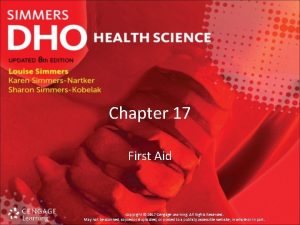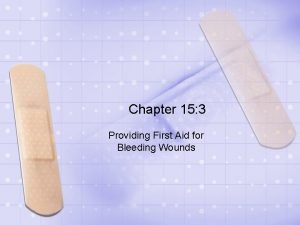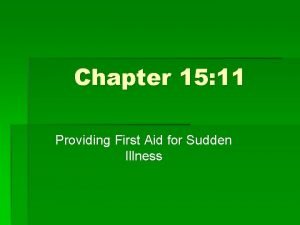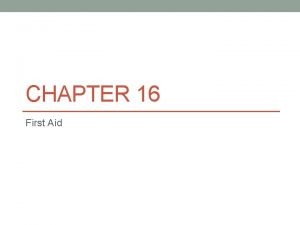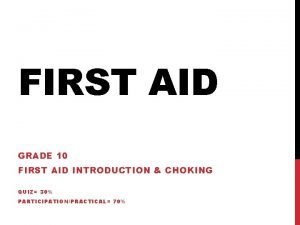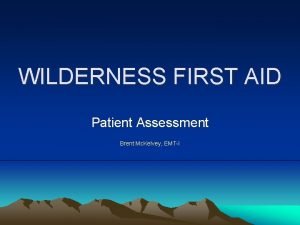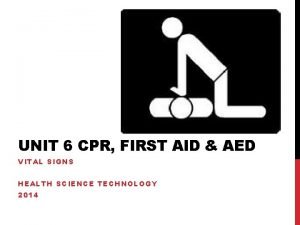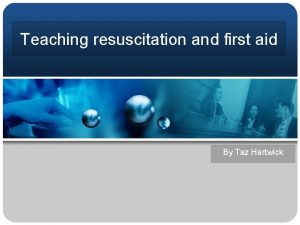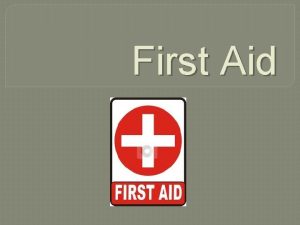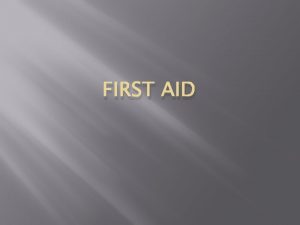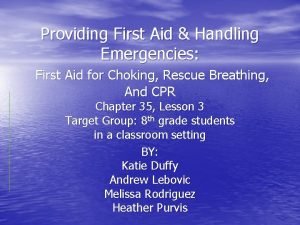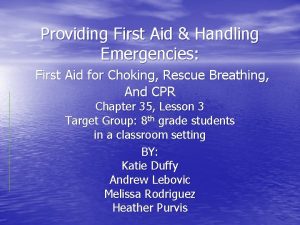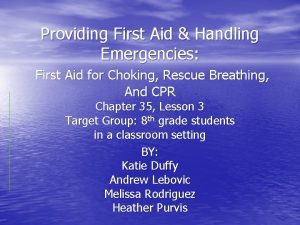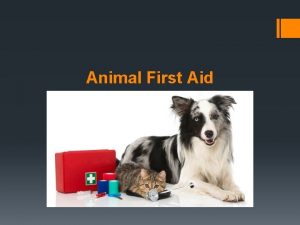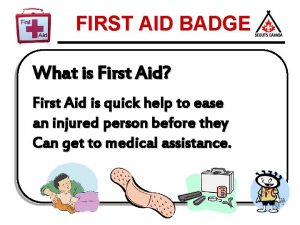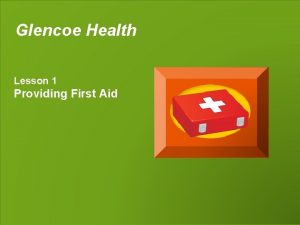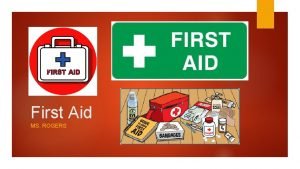Providing First Aid Chapter 28 Lesson 1 Universal















- Slides: 15

Providing First Aid Chapter 28 Lesson 1

Universal Precautions ⦿Actions taken to prevent the spread of disease by treating all blood and other body fluids as if they contained pathogens. ⦿Why is this important when responding to an emergency? ⦿What are some practices that would be considered universal precautions?

Check, Call, Care 1. 2. 3. Check the scene and the victim: do not move the victim unless they are in immediate danger. Call for help: call 911, if someone else is available have them call and stay with the victim. Provide care for the victim: If possible get the victims permission before providing first aid. Always address lifethreatening emergencies first.

OPEN WOUNDS FOUR TYPES: 1. ABRASION 2. LACERATION 3. PUNCTURE 4. AVULSION

Abrasion ⦿Tiny blood vessels in the outer layer of the skin break, resulting in an abrasion. �Clean the wound and cover with a band-aid or dressing.

Laceration ⦿A cut caused by a sharp object , such as a knife or broken glass, slicing through layers of skin. �Some lacerations may require stitches and the person should be brought to the ER.

Puncture ⦿A small but deep hole caused by a pin, nail, fang, or other object that pierces the skin. �May cause internal bleeding, person should go to the ER because of a high chance of infection.

Avulsion ⦿Results when tissue is partially or completely separated from the body. �Person must seek medical attention, if body part is completely severed pack it in ice and bring it to the ER.

First Aid for Bleeding 1 2 ⦿ DO NOT attempt to clean a severe open wound such as an avulsion or laceration. ⦿ ALWAYS wash your hands before treating an open wound ⦿ Cover the wound with sterile gauze or clean cloth, press firmly ⦿ Elevate the wound above the level of the heart. ⦿ Cover gauze or cloth with a sterile bandage ⦿ If necessary cover with a pressure bandage or use pressure point control ⦿ Call for help

APPLYING A PRESSURE BANDAGE & Tourniquet Pressure Bandage Tourniquet

Pressure Point Bleeding Control

Types of Burns and Treatment You. Tube - Types of Burns - First_ Second_ and Third-Degree Burns Video. flv First-Degree Burns Second-Degree Burns Third-Degree Burns Only outer layer is burned and turns red. Cool with cold running water or by immersing it in cold water (NOT ICE). Pat area dry and wrap with a bandage. The top several layers of skin are damaged. Skin will blister and appear blotchy. Cool with cold water (NOT ICE) and elevate the burned area. Wrap with loose sterile, dry dressing. Do not pop or peel loose skin. Serious burn is which deeper layers of the skin possibly fat, muscle, nerves, and bone are damaged. Seek professional medical help. Cool burn with cold water (NOT ICE).

1 st Degree Burn

2 nd Degree Burn

3 rd Degree Burn
 Chapter 17:4 providing first aid for shock
Chapter 17:4 providing first aid for shock Chapter 17:6 providing first aid for burns
Chapter 17:6 providing first aid for burns 16:3 providing first aid for bleeding and wounds
16:3 providing first aid for bleeding and wounds 16:11 providing first aid for sudden illness
16:11 providing first aid for sudden illness Chapter 16:1 providing first aid
Chapter 16:1 providing first aid First aid merit badge first aid kit
First aid merit badge first aid kit Unit 15:3 providing first aid for bleeding and wounds
Unit 15:3 providing first aid for bleeding and wounds Objective of first aid
Objective of first aid Emergency care first aid and disasters
Emergency care first aid and disasters Chapter 28 first aid and emergencies
Chapter 28 first aid and emergencies St andrew medical centre
St andrew medical centre First aid patient assessment form
First aid patient assessment form Air cadets badge placement
Air cadets badge placement Hypertension vs hypotension
Hypertension vs hypotension Coyne first aid
Coyne first aid Chample first aid
Chample first aid
